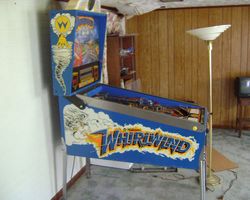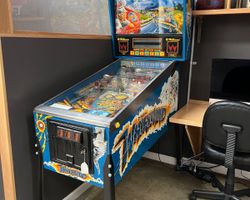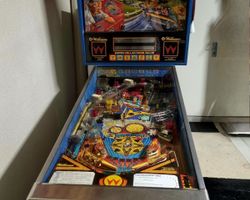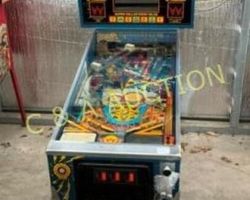Whirlwind

Average Prices: USD $400 to $2,700
Produced: January, 1990
Production Run: 7,300 units
Machine Type: Solid State Electronic
MPU: Williams System 11B
Players: 4
Concept by: Pat Lawlor
Design by: Pat Lawlor
Art by: John Youssi
Mechanics by: John Krutsch, Jack Skalon
Music by: Chris Granner
Sound by: Chris Granner
Software by: Bill Pfutzenreuter
Williams Electronic Games introduced a captivating pinball machine in January 1990, pulling players into the heart of a powerful meteorological event. This machine, themed around the raw force of a storm, quickly distinguished itself within the vibrant pinball landscape, offering an experience designed to be both thrilling and unpredictable. Its concept, focusing on the dynamic and chaotic nature of weather, allowed for the integration of innovative features that directly influenced gameplay and player immersion.
The design and production of this pinball machine were spearheaded by a team of highly skilled individuals. Pat Lawlor, a key figure in pinball design, conceived the game's core ideas and playfield layout. His vision for a fast-paced and engaging experience was central to its creation. John Youssi contributed the distinctive artwork, imbuing the machine with a vibrant, energetic visual style that perfectly captured the storm theme. The sounds and music, crafted by Chris Granner, were integral to building the atmosphere, featuring custom speech and an electronic score that intensified the gameplay. Software development was handled by Bill Pfutzenreuter, ensuring the ruleset and play mechanics functioned seamlessly, while Jack Skalon and John Krutsch were responsible for the mechanical engineering, bringing Lawlor's design concepts to life.
Released as a System 11B game, this machine entered production on January 11, 1990, and concluded on April 12, 1990. During this period, 7,304 units were manufactured, indicating a significant commercial success for Williams. The machine’s initial impact was bolstered by its unique blend of theme and mechanical innovation, quickly becoming a fixture in arcades and entertainment venues. An interesting piece of trivia from its development concerns the backglass artwork: artist John Youssi incorporated personal elements, including a caricatured version of his own van and an English Setter dog, which mirrored his own pet. The "hand on the button" motif, a recurring element in future Lawlor designs, also made its first appearance here. Furthermore, an early version of the translite depicted a character wearing a baseball cap with a Chicago Cubs logo; this was later covered with a Williams "W" sticker due to licensing considerations before new translites were printed. The machine's lasting appeal is also evidenced by its appearance in popular culture, notably in the opening diner scene of the movie Natural Born Killers.
Signature Features and Design
Central to the experience of this Williams pinball machine are its distinct features, which fundamentally shape gameplay and player interaction. The most immediate and striking element is the fan mounted in the backbox, which physically blows air towards the player during various moments, most prominently during multiball. This innovative physical effect directly amplifies the storm theme, creating a tangible sense of being "in the whirlwind" and adding a unique layer of immersion not commonly found in pinball machines of its era.
Equally impactful are the three spinning discs embedded in the center of the playfield. These dynamically rotating elements introduce an unpredictable chaos to ball movement, deflecting shots and sending the pinball in unexpected directions. They demand constant player adaptation and quick reflexes, ensuring no two games unfold identically. The discs are more than mere obstacles; they are integral to the game’s core identity, embodying the erratic nature of a storm.
John Youssi's artwork ties these elements together, presenting a visually cohesive and captivating theme. The vibrant, stormy palette and dynamic depictions of wind and lightning across the playfield and backglass perfectly complement the mechanical features. Coordinated lighting effects flash in conjunction with the fan and spinning discs, creating a sensory synergy that draws the player deeper into the storm narrative. This deliberate integration of physical effects, unique playfield mechanisms, and evocative artwork elevates the pinball experience beyond simple target hitting, making it a masterclass in thematic execution.
Playfield and Mechanics
The playfield of this Williams pinball machine is a testament to Pat Lawlor’s design philosophy, characterized by its open layout, fast flow, and emphasis on repeatable shots. The lower playfield features the standard two main flippers, complemented by a crucial upper right flipper that provides access to specific, often high-scoring shots in the upper regions of the playfield.
Two distinct ramps dominate the playfield's upper half. The left ramp provides a smooth, consistent shot, while the right ramp incorporates a clever mechanical innovation: a diverter that can either allow the ball to travel up the ramp or drop it into a saucer target concealed beneath. This dynamic element adds strategic depth, as players must adapt to the ramp's current state to optimize their shot selection.
Below the ramps, the mid-playfield is defined by the three spinning discs, which are strategically placed to create a chaotic zone that tests a player's ball control. Surrounding these discs and across the playfield are various targets essential for progressing through the game's objectives. These include a bank of three drop targets, a solitary drop target, and multiple standup targets. Six pop bumpers are positioned to create a lively, high-scoring area, ensuring constant ball movement and unpredictability. Two "cellar holes" are prominent features, offering awards when successfully shot, a concept so strongly associated with this machine that the term "cellar hole" itself found common usage within the pinball community from this game. A left-side kickback lane provides a valuable save mechanism, returning the ball to play and extending rallies. The overall flow encourages players to chain ramp shots, navigate the spinning discs, and complete target banks, all while keeping an eye on the unpredictable trajectory of the ball. The artwork on the playfield, with its sweeping lines and storm-related imagery, guides the eye towards key shots and provides a constant visual reminder of the overarching theme. The lighting is strategically placed to highlight active shots and modes, guiding the player through the unfolding storm.
Gameplay Dynamics
The gameplay dynamics of this Williams pinball machine are designed to be immediately engaging yet offer layers of depth for extended play. At its core, the objective is to generate high scores by hitting key shots, activating modes, and initiating multiball. The game’s progression is intuitive, often revolving around collecting storm features to build up towards major scoring opportunities.
One of the primary goals for players is to achieve the 3-ball multiball, a chaotic and rewarding experience where the backbox fan activates, physically blowing air on the player as multiple pinballs race across the playfield. Initiating multiball typically involves completing a series of shots or objectives, making it a satisfying culmination of effort. Beyond multiball, the game features distinct objectives such as lighting and shooting the "Cellar Door" awards, which are collected from the kick-out holes. Players also aim to complete the drop targets and standup targets to light various features and increase their bonus multiplier.
Strategic play involves mastering the ramp shots, particularly the left ramp for consistent scoring and the dynamic right ramp with its diverter mechanism. Controlling the ball amidst the three spinning discs is a perpetual challenge; players must learn to anticipate their effect on ball trajectory to maintain control and line up subsequent shots. The upper right flipper is crucial for precision shots to the upper playfield targets and ramps, allowing for a more deliberate approach to certain objectives. The callouts and electronic soundtrack, crafted by Chris Granner, provide auditory cues that enhance the gameplay, building tension as the storm intensifies and rewarding players for successful shots. Despite its accessible ruleset, the game's fast pace and the inherent unpredictability introduced by the spinning discs ensure that each game presents a fresh challenge, requiring quick reflexes and adaptable strategies to achieve a high score.
Reception and Legacy
The reception of this Williams pinball machine among enthusiasts and collectors has been overwhelmingly positive since its release. It is widely regarded as a benchmark title from the early 1990s, frequently cited for its innovative features and engaging gameplay. Players often praise its fast, flowing shots and the satisfying rhythm that develops from hitting repeatable ramps and targets. Many appreciate the straightforward yet compelling ruleset, which makes the game accessible to newcomers while offering sufficient depth to keep seasoned players challenged and returning for more. The integration of its unique theme is consistently highlighted as a strength; the fan topper, spinning discs, and coordinated sound and lighting effects are lauded for creating an immersive and memorable storm experience that truly sets it apart. The custom callouts and electronic music also contribute significantly to its identity, building a palpable atmosphere of an approaching and escalating storm.
Despite its broad acclaim, some feedback points to areas where the machine could be perceived as less forgiving. A common critique revolves around the game's tendency for quick drains, which can lead to shorter ball times for less experienced players. While the spinning discs are a signature feature, their unpredictable nature can sometimes be a source of frustration, as balls can be unexpectedly diverted into outlanes or unfavorable positions. Some players also find certain callouts or sound effects to become repetitive over extended play. Additionally, while the "Cellar" holes are a thematic highlight, the ball can occasionally become trapped or spend too much time in these areas, interrupting the flow of gameplay. A smaller segment of the community expressed a desire for a more complex or deeper ruleset, preferring intricate progression paths over the game's more direct approach to objectives and scoring.
Regardless of these minor points, the pinball machine has solidified its position as a true classic in pinball history. It is a highly respected example of Williams' System 11B era and holds a strong reputation among collectors and players alike. Its influence is undeniable, particularly in its daring integration of physical environmental effects like the fan, which was a novel concept at the time and pushed the boundaries of player immersion. The successful implementation of the spinning discs also demonstrated how dynamic playfield elements could be used to create unique challenges and add replayability. As one of Pat Lawlor's early successes, it established key elements of his design signature—fast flow, engaging mechanics, and strong thematic integration—paving the way for his later highly celebrated pinball titles. Its enduring popularity is underscored by the continued demand for well-maintained examples and even modern re-interpretations that seek to honor its innovative spirit.
Sponsored Links
 Ebay Listings
Ebay Listings
 Auction Results
Auction Results
| Cost | Location | Date |
|---|---|---|
| USD $3,500 |  California, United States California, United States |
24 June, 2025 |
| USD $8,900 |  Florida, United States Florida, United States |
22 May, 2025 |
| USD $4,000 |  Georgia, United States Georgia, United States |
05 May, 2025 |
| USD $4,200 |  Florida, United States Florida, United States |
18 March, 2025 |
| AUD $6,000 |  Western Australia, Australia Western Australia, Australia |
16 March, 2025 |
| USD $3,500 |  New Jersey, United States New Jersey, United States |
15 December, 2024 |
| USD $6,000 |  West Virginia, United States West Virginia, United States |
23 November, 2024 |
| USD $4,000 |  Arizona, United States Arizona, United States |
06 November, 2024 |
| EUR €1,499 |  Czech Republic Czech Republic |
09 June, 2024 |
| USD $5,489 |  Florida, United States Florida, United States |
22 May, 2024 |


Private Policy · Search Website · Contact Us
As an eBay Partner, we may earn a commission from qualifying purchases made through links on this site, at no additional cost to you.
All trademarks and copyrighted materials remain property of their respective owners. All other content copyright 2007 - 2025 Pinpedia.







